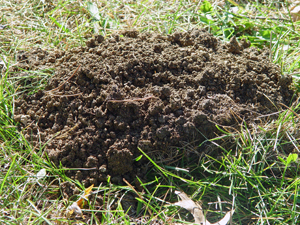Moles
 The signs of mole activity are fairly clear once you know what to look for. Raised tunnels, cracked earth, and sometimes accompanying mounds that have no entrance hole are all signs you have an issue. Another good sign- the ground sinks as you walk (these are the tunnels collapsing).
The signs of mole activity are fairly clear once you know what to look for. Raised tunnels, cracked earth, and sometimes accompanying mounds that have no entrance hole are all signs you have an issue. Another good sign- the ground sinks as you walk (these are the tunnels collapsing).
Adult moles are between 5.5”-7.5” in length and may weigh between 2 and 3.5 ounces. They are very active and seek food day and night all year long. Earthworms and larval insects are their preferred food source and moles can consume up to half of their weight each day.
Moles breed in late winter and early spring producing an average of four young in April or May. At approximately four weeks of age the young moles leave the nest and are on their own.
Mole mounds and tunnel damage
Problems associated with moles are surface tunnels and mounds or molehills found in lawns, golf courses and cemeteries. The upheaved ridges of mole tunnels are unsightly and can make lawn mowing difficult. When tunnels are located close to the surface the roots of nearby plants can be negatively impacted and the plants can turn color or in some instances die.
How to get rid of moles
The surest way to control mole damage is to remove them from the area by trapping. Baits and repellents are not effective methods of managing them.
The three most common mole traps include
- scissor-jawed,
- harpoon, and
- choker loop.
All are placed within an active, existing tunnel and are set off as the mole passes through. Find a tunnel the mole is currently using by stepping on it to compress the tunnel or use a broomstick to poke a hole in it. If it is repaired the next day, you've found an active tunnel.
Place a trap in an active run by excavating soil, placing the trap and then replacing loose soil. Secure the trap so that the recoil will not lift the trap out of the ground. Make sure the triggering mechanism is not in the center of the run.
Push down two holes, one on each side of the trap. Moles should be caught when they try to repair the tunnel. Move the traps if no moles are caught within three days.
For more detailed information on these traps please see the publication Controlling Nuisance Moles. One of the secrets for successfully trapping moles is to find an active tunnel. There is a very short video showing how to find an active tunnel at the link listed here.
